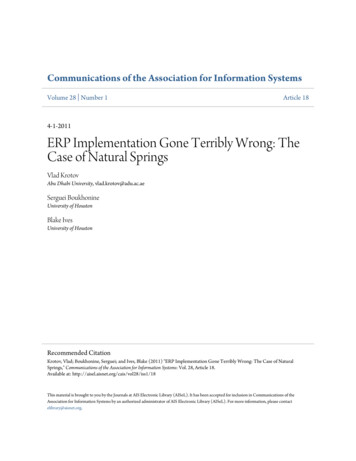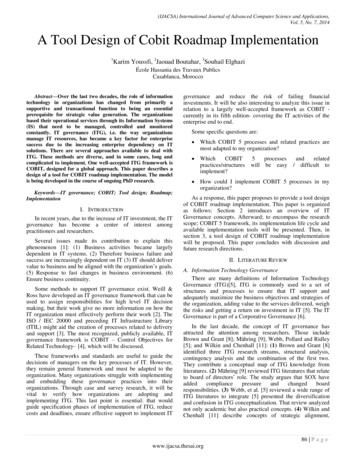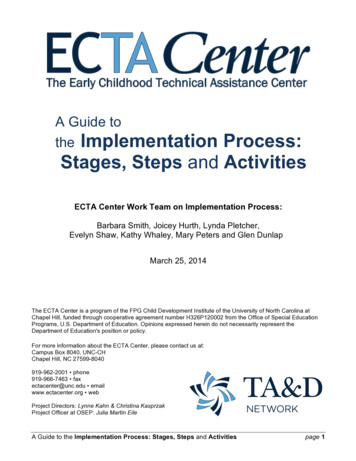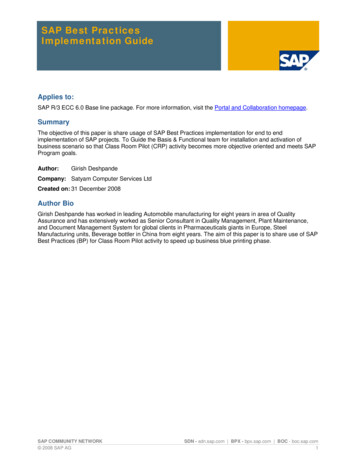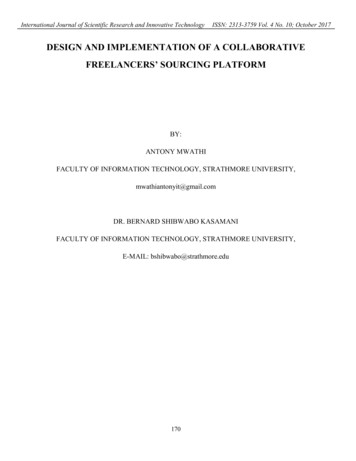
Transcription
International Journal of Scientific Research and Innovative TechnologyISSN: 2313-3759 Vol. 4 No. 10; October 2017DESIGN AND IMPLEMENTATION OF A COLLABORATIVEFREELANCERS’ SOURCING PLATFORMBY:ANTONY MWATHIFACULTY OF INFORMATION TECHNOLOGY, STRATHMORE UNIVERSITY,mwathiantonyit@gmail.comDR. BERNARD SHIBWABO KASAMANIFACULTY OF INFORMATION TECHNOLOGY, STRATHMORE UNIVERSITY,E-MAIL: bshibwabo@strathmore.edu170
International Journal of Scientific Research and Innovative TechnologyISSN: 2313-3759 Vol. 4 No. 10; October 2017AbstractThe Information Age has affected the workforce in several ways. Workers are also being forced to compete in aglobal job market. Technology has increased job opportunities in developing countries and has promoted theglobalization of the workforce. Often, workers in low income or developing countries have a competitiveadvantage which translates into increased opportunities and higher wages. This research was targeted atproviding a platform to which, people can sign up according to their skill set or talents and have access tonumerous job opportunities. Therefore, freelancers of different skill sets, and expertise can engage and interactwith different opportunities. A place where they can work hand in hand with different people on the sameindustry or collaborate with fellow freelancers to achieve various tasks assigned. To achieve a high level ofscalability and platform performance, PHP, MySQL, JavaScript and Node JS, were used for developing theserver-side. Node.js has an event-driven architecture capable of asynchronous I/O. These design choices aim tooptimize throughput and scalability in Web applications with many input/output operations, as well as forreal-time Web applications. The solution promotes freelancing and self-employment with the use of technology.1. IntroductionThe Information Age has affected the workforce in several ways. It has created a situation in which workers whoperform tasks which are easily automated are being forced to find work which involves tasks that are not easilyautomated (Porter, 2015). Workers are also being forced to compete in a global job market. Lastly, workers arebeing replaced by computers that can do their jobs faster and more effectively. This poses problems for workersin industrial societies, which are still to be solved.However, solutions that involve lowering the working time are usually highly resisted. Castells (1999) said thatJobs traditionally associated with the middle class (assembly line workers, data processors, foremen andsupervisors) are beginning to disappear, either through outsourcing or automation. Individuals who lose theirjobs must either move up, joining a group of "mind workers" (engineers, doctors, attorneys, teachers, scientists,professors, executives, journalists, consultants), or settle for low-skill, low-wage service jobs.The "mind workers" are able to compete successfully in the world market and receive high wages. Conversely,production workers and service workers in industrialized nations are unable to compete with workers indeveloping countries and either lose their jobs through outsourcing or are forced to accept wage cuts(Reich,2012). In addition, the internet makes it possible for workers in developing countries to provide171
International Journal of Scientific Research and Innovative TechnologyISSN: 2313-3759 Vol. 4 No. 10; October 2017in-person services and compete directly with their counterparts in other nations.This has had several majorconsequences, including increased job opportunities and the globalization of the workforce.In Kenya,for example, only half of the more than 50,000 students who graduate annually are suitable foremployment. Additionally, of these graduates, more than half are not suited to their career choice (Wesangula,2014). The unemployment rate in Kenya is 40% this means that 4 out of 10 Kenyans are unemployed. Most ofthese people are youth in their 20s and have just left school. Unfortunately, they cannot fill in positions as theyhave spent a lot of their time in school and have no job experience to show(Mwangi et al., 2016).Many youths in the end choose to go back into school and get more education – which is not what they need.What they need is work experience. The problem is that when someone shows up at your interview with a PhDbut only 2 years of work experience, the employer gets worried. Can they be a good manager? Will they be ableto navigate the workplace dynamics? Can they deliver under pressure? Can they own up to mistakes and bringviable solutions to the table?(Mwangi et al., 2016). And all of these question have a certain level of validity tothem, but every man/woman has had to start from somewhere, as a novice, an apprentice to master, and withtime gained experience to a certain level of competency.2. Literature ReviewThe youth, more particularly the educated variety are embroiled in a dilemma after school on whether to seekemployment or contemplate the pursuing of a business venture in the face of competition. Competition hasmade it incumbent upon business to strive to survive tough economic times. Survival has seen retrenchmentsand layoffs hence pondering serious questions on the future of youth(Omido, 2016).With the ever-growing number of competitors in the marketplace, talent is the only differentiator. Capital isabundant while technology is easy to access, but the brainpower of knowledge and experienced staff is the mostimportant asset for the modern, progressive organization.It is, therefore, alarming when more than half — 54.2 per cent — of respondents say that their biggest challengeis retaining top talent, as talent retention increasingly determines the success or failure of many organizations.Further, 50.3 per cent and 43.5 per cent of the employers say providing competitive compensation and managingorganizational changes, respectively, is a major hurdle (Ochieng’, 2015).172
International Journal of Scientific Research and Innovative TechnologyISSN: 2313-3759 Vol. 4 No. 10; October 2017While 37.3 per cent face employee morale challenges, 24.9 per cent experience challenges in recruiting highskilled applicants, 26.6 per cent have problems maintaining productivity levels, 25.4 per cent cite upwardmobility for their employees as a challenge, 12.4 per cent mention worker burnout, 16.9 per cent employeeengagement and 11.3 per cent indicate that they have experienced the challenge of cutting down on cost per hire(Ochieng’, 2015).Figure 1 indicates the rates at which employers are willing to hire fresh graduates from both public and privateuniversities in Kenya. Figure 1 illustrates the percentages of students accepted to a job after graduating from apublic campus, with a sample size of eleven public universities based here in Kenya.Figure 1 : Public University Job Acceptance Percentages(Adapted From Nation Kenya, 2015)173
International Journal of Scientific Research and Innovative TechnologyISSN: 2313-3759 Vol. 4 No. 10; October 2017Figure 2 illustrates the percentages of students accepted to a job after graduating from a private campus.With asample size of ten private universities based here in Kenya.Figure 2: Private University Acceptance Percentages (Adapted from Nation Kenya, 2015)2.2 Traditional Approach to Freelance Job/Task AcquisitionWith the rise in the use of the internet as a medium to helping us enhance the way we do business, it has alsorevolutionized the way a job search is done. But as the internet impact grows, traditional methods like classifiednewspaper advertisements, network of the people around you, phone book directories, and such play yet a bigrole on the shift of job seeking(Clements, 2016).2.2.1 Job Acquisition Techniquesi. The Cold Cover Letter/ResumeIt is estimated that 80% of the job openings are never advertised or published to the public: rather they are filledwith from internal postings, through people networking and resumes on a file. 80% is a huge chunk of a marketopportunity, which remain untapped. There are success stories that exist using this method of job seeking, butthe hugest disaster remains to the tedious and time inefficiency that comes along with the approach(Clements,2016).174
International Journal of Scientific Research and Innovative TechnologyISSN: 2313-3759 Vol. 4 No. 10; October 2017Potential Advantages of Cover Letter ApproachA) Gaining early consideration for a position that has not yet been advertisedB) Being part of a company’s upcoming expansion plansC) Creating a job that previously did not existD) Consideration to fill a position created by an upcoming promotion, transfer, termination or resignation.E) Increase your network of contacts and having your resume forward on for more possible considerationsii.The Classified AdvertisementsIt almost comes with no doubt to how the classified newspaper ads, are losingtheir place in the job searchindustry, but there are still many jobs listed in the classified ads especially with local companies and smallbusinesses. Many forget that most countries are still built on the small business owners so unless your heart is seton working for a major; regional, national or international company then the classified ads may have your nextjob listed. One thing to remember today’s small business can be tomorrows major corporation and how excitingto be part of that growth. We recommend reviewing the major newspapers in your area and also pick up the smalllocal papers they also have local postings. (Clements, 2016)2.3 Modern Approach to Freelance Job/Task AcquisitionJob searching has seen a great change over the last 10 years or so. The reality is that the internet has trulychanged the dynamics of it all.There are aspects of your resume and online profile that can easily date you if youdo not take steps to update your approach. This puts you in danger of rejection before you even manage to get aninterview. There are aspects of your resume and online profile that can easily date you if you don't take steps toupdate your approach. This puts you in danger of rejection before you even manage to get an interview(“Traditional versus non-traditional job search techniques,” n.d.).175
International Journal of Scientific Research and Innovative TechnologyISSN: 2313-3759 Vol. 4 No. 10; October 20172.3.1 Examples of Freelance PlatformsWhether most freelancers are looking for another way to pay the bills, seeking more professional developmentopportunities or just love the freedom that freelancing offers, there is no question that millions of people havediscovered the benefits of professional freelancing. As trends like the digital nomad lifestyle grow in popularity,the number of freelance resources out there has increased as well(Madden, 2010).Below is a number of the well-known and established freelancing platforms globally:A) UpWorkWith a whooping number of about 1.5 million clients, UpWork offers something for almost every type offreelancer. UpWork accommodates both long- and short-term projects, hourly or per project work, with expertlevel and entry level engagements. Regardless of where you are in one’s career, UpWork caters foryou(Johansson, 2015).B) ToptalToptal offers, a distinctively different approach towards freelancing, Toptal is for seasoned, talented freelancers.It includes a screening process, of which after passing one has access to meaningful projects with great clientssuch as JP Morgan, AirBnB, and ZenDesk etc. and topped with fair compensation (no low bid contests). Alsoafter the screening process one has opportunity to join the community for frequent meetings and techweeks(Johansson, 2015).C) FreeLancerIndifferent from most platforms, Freelancer in addition to access to a million different projects, Freelancerallows you to compete with other freelancers in contests to prove one’s skill set. It promotes a great way towhich competitive and confident people at their expertise can contest to prove their skill and acquire moreclients(Firdaus, 2007).176
International Journal of Scientific Research and Innovative TechnologyISSN: 2313-3759 Vol. 4 No. 10; October 2017D) CraigslistOver the years, craigslist has been thought to be a platform for selling and buying malicious things, it stillremains a great platform to which freelancers acquire new clients. It offers the flexibility to work withcompanies remotely or locally depending on the freelancers’ preference(Firdaus, 2007).E) GuruWith Guru, they follow a different approach to freelancing and offer a way to which one can easily showcasetheir past work experiences. To top it up they offer a daily job-matching feature to make sure one does not missout on any great opportunity available through their platform(Johansson, 2015).3. MethodologyThe project was developed using the systems development life cycle methodology with an aim of solving theproblem. This method was chosen because it follows a simple yet efficient means of development of theinformation system.The software development life cycle (SDLC) is a framework defining tasks performed at each step in thesoftware development process. SDLC is a structure followed by a development team within the softwareorganization. It consists of a detailed plan describing how to develop, maintain and replace specific software.The life cycle defines a methodology for improving the quality of software and the overall development process.SDLC consists of following activities:i.Planning: The most important parts of software development, requirement gathering or requirementanalysis are usually done by the most skilled and experienced software engineers in the organization.After the requirements are gathered from the client, a scope document is created in which the scope ofthe project is determined and documented.ii.Implementation: The software engineers start writing the code according to the client's requirements.iii.Testing: This is the process of finding defects or bugs in the created software.iv.Documentation: Every step in the project is documented for future reference and for the improvement ofthe software in the development process. The design documentation may include writing the applicationprogramming interface (API).v.Deployment and maintenance: The software is deployed after it has been approved for release.177
International Journal of Scientific Research and Innovative TechnologyISSN: 2313-3759 Vol. 4 No. 10; October 20174. System Design and Architecture4.1 Requirements AnalysisA Freelancer can register themselves through the work4fce platform, after which they will have the opportunityto build their profile, or delete their account. He or She can also go ahead and start applying for job vacanciesthat are listed with the database.4.1.1 Functional RequirementsThe Hound Platform is designed to be a sole platform that helps companies seek professional to expert skills fortheir projects or team collaboration, and at the same time provide freelancers with a place to which they canacquire work easily, and get paid from the Hound Platform. The proposed Hound platform must be able toimplement the following functions: i. Management of the platform users, the login-process, password changing, third-party sign-up andsign-in authentication, Facilitated the Hound Payment process for work done, Gathering key usermetrics.ii. Data Management: Managing of job/projects uploads and project acquisition which includes; Projecttypes/categories, Project Budget, Payment Options, Transactions details and authorization.iii. Outputting Reports: A catalogue report, Job Listing report.iv. Innovation: Happens in how specific projects are categorized to be in various access portals under thesame Hound Platform.4.1.2 Non-Functional RequirementsIn this section, the factors that are not related to the specific functional requirements of the program arementioned. The application manages a huge volume of database, so the database must be suitable for fastgrowing data.Due to the nature of the program, there will be plenty of reports to be generated; therefore, the graphical userinterface is a key element that should be paid attention to, it should be user- friendly and easy-to-use especiallyon the necessary features which the interface must have. In addition, the reports in this program must displayenough columns and information that the user needs for making the statistics of the status of asset etc.Finally, only the people who have responsibility of managing the assets have the privilege to access the system.178
International Journal of Scientific Researchrch aand Innovative TechnologyISSN: 2313-3759 Vol. 4 No. 10; October 2017As an organization (client), one can also build their profile, set their general hiring rate forf the projects. Theyalso list what jobs they are offering,ng, anand set all necessary information that thee job(project)job(prequires. Anorganization can at any time receivee propproposals from interested parties(freelancers)) showcasingshowtheir interest.And it is up to the organization to choose the right freelancer based on their skillset,set, pastpa experiences, or thequality of their profile. Figure 3 presentssents tthe use case diagram.Figure 3: Use Case Diagram179
International Journal of Scientific Researchrch aand Innovative TechnologyISSN: 2313-3759 Vol. 4 No. 10; October 20174.2 System DesignFigure 4 presents the class diagram.Figure 4: Class Diagram180
International Journal of Scientific Researchrch aand Innovative TechnologyISSN: 2313-3759 Vol. 4 No. 10; October 2017Figure 5 presents the Database schema.Figure 5: Database Schema181
International Journal of Scientific Research and Innovative TechnologyISSN: 2313-3759 Vol. 4 No. 10; October 20175. Implementation and TestingSystems Development and Implementation involves the transformation of the initial idea and specific objectivesof an intended information system to an actual solution to meet the business needs of an organization.Implementation involves putting the system into place, allowing users to interact with it and making sure usersare well conversant and understand how the system is meant to work.5.2 System Development and Tools Used(i) Front end: The web based system was coded using PHP scripting language and CSS (Cascading stylesheets) to help structure and design the web-pages that will interact with the system users. Theframework used to manipulate and write PHP AND CSS was Laravel. PHP language was chosenbecause of its widespread use at a global scale with multiple web browsers compatibility across varioussoftware platforms and various end user devices.(ii) Back end: PHP and JavaScript was used to develop the back end structure to develop systemfunctionality modules. Code Igniter was used to code these two back end languages. PHP was chosen forit compatibility and ability to work seamlessly with HTML. PHP code can easily be embedded in HTMLpages as well as process form data collected from HTML pages by storing and retrieving such data to andfrom a MySQL database.(iii)Database and Hosting: SequelPro was used to interact with the database and it acts as a local hostenvironment while testing and implementing the system. SequelPro has a Database GUI module thathelped develop the database using MySQL (Structured Query Language). SequelPro was selected for itsability to host PHP pages and run MySQL queries through its GUI.5.3 System ImplementationAs for the minimum requirements of the system, the web server required to host the system will need to be PHP5.5 and MySQL compatible. End user devices such as laptops or desktops will need to have an updated webbrowser, Stable and secure internet connection in order to login and make payments and also do the bidding,means of payment such as PayPal to carry out transactions and finally a PDF viewer to be able to read the reportsgenerated by the system. Figure 6 and Figure 7presents the implementation in form of sample programmingcode segments.182
Inter
It is estimated that 80% of the job openings are never advertised or published to the public: rather they are filled with from internal postings, through people networking and resumes on a file. 80% is a huge chunk of a market opportunity, which remain untapped. There are success stories that exi

